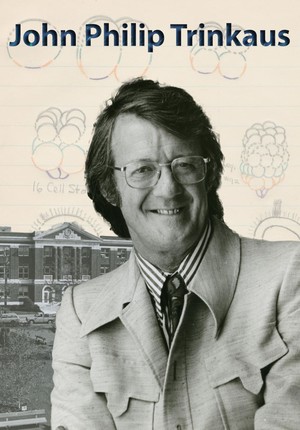In the early 1970s, Trinkaus, along with several doctoral and post-doctoral students, including Cheryll Anne Tickle, conducted research at the MBL on cell motility in Fundulus, during the months of June and July, for several consecutive years. By using Fundulus embryos as their model organism, Trinkaus and his colleagues could clearly track the motility of individual cells in the blastoderm during gastrulation and record changes in the cell’s surface and shape in vivo. Their initial research showed that while blastomeres are mostly inactive (except during cell division), they begin to show changes in their cell surface structure as they approach the process of gastrulation. This onset of motility in blastomeres happens very gradually and eventually the ripples on the cell surface develop into blebs, or small mobile cortical blisters (Trinkaus 2003, 233; Trinkaus 1973). Blebs continue to form on the cell surface, retracting and expanding continuously. The blastomeres continue this frantic activity into the late blastula stage of development right until the beginning of gastrulation. Trinkaus eloquently describes this process in his autobiography:
“At first, few cells form blebs, but, with time, the number increases steadily until by the late blastula stage, before the beginning of gastrulation, almost all deep cells are forming and retracting blebs and the blastoderm is converted into a bubbling, jostling cell mass. What a show! During this frantic but brief phase of development the cells do not change location; they just sit there merely blebbing – exercising in place, as it were” (Trinkaus 2003, 233).
- Atz, James W. "Fundulus heteroclitus in the laboratory: a history." American zoologist 26, no. 1 (1986): 111-120.
- Betchaku, Teiichi, and J. P. Trinkaus. “Programmed endocytosis during epiboly of Fundulus heteroclitus.” American zoologist 26, no. 1 (1986): 193-199.
- Davis, Edward M., and J. P. Trinkaus. "Significance of cell-to-cell contacts for the directional movement of neural crest cells within a hydrated collagen lattice." Journal of embryology and experimental morphology 63, no. 1 (1981): 29-51.
- DuPont, Ellen M. "John Philip Trinkaus (1918-2003)." Embryo Project Encyclopedia (2012).
- Goodrich, H. B., and J. P. Trinkaus. "The differential effect of radiations on mendelian phenotypes of the goldfish, Carassius auratus." The Biological Bulletin 77, no. 2 (1939): 192-199.
- Goodrich, H. B., and J. P. Trinkaus. "The differential effect of radiations on mendelian phenotypes of the goldfish, Carassius auratus." The Biological Bulletin 77, no. 2 (1939): 192-199.
- Goodrich, H. B., N. D. Josephson, J. P. Trinkaus, and Jeanne M. Slate. "The cellular expression and genetics of two new genes in Lebistes reticulatus." Genetics 29, no. 6 (1944): 584-592.
- Keller, Ray, Wallis H. Clark, and Frederick Griffin (Eds.) Gastrulation: Movements, Patterns, and Molecules. New York: Plenum Press, 1991.
- Kimmel, Charles B., and James A. Weston. "An overview of Trink's scientific accomplishments." Developmental Dynamics 228, no. 4 (2003): 586-587.
- Saunders, John W. "Trink, the man." Developmental Dynamics 228, no. 4 (2003): 588-590
- Schoenwolf, Gary C. "Trink: His life, his philosophy." Developmental Dynamics 228, no. 4 (2003): 591-593.
- Tickle, Cheryll A., and J. P. Trinkaus. "Change in surface extensibility of Fundulus deep cells during early development." Journal of cell science 13, no. 3 (1973): 721-726.
- Tickle, Cheryll A, and J. P. Trinkaus. "Observations on nudging cells in culture." Nature 261, no. 5559 (1976): 413-413.
- Trinkaus, J. Philip. "Factors concerned in the response of melanoblasts to estrogen in the Brown Leghorn fowl." Journal of Experimental Zoology 109, no. 1 (1948): 135-169.
- Trinkaus, John Philip. "The surface gel layer of Fundulus eggs in relation to epiboly." Proceedings of the National Academy of Sciences of the United States of America 35, no. 4 (1949): 218.
- Trinkaus, John Philip. "A study of the mechanism of epiboly in the egg of Fundulus heteroclitus." Journal of Experimental Zoology 118, no. 2 (1951): 269-319.
- Trinkaus, John Philip. "The differentiation of tissue cells." American Naturalist (1956): 273-289.
- Trinkaus, John Philip. “Procurement, maintenance and use of Fundulus eggs,” Methods in Developmental Biology. F.H. Wells and N.K. Wessells (Eds.) Crowell, New York: 1967, 113-122.
- Trinkaus, J. P. "The cellular basis of Fundulus epiboly. Adhesivity of blastula and gastrula cells in culture." Developmental biology 7 (1963): 513-532.
- Trinkaus, J. P. "Surface activity and locomotion of Fundulus deep cells during blastula and gastrula stages." Developmental biology 30, no. 1 (1973): 68-103.
- Trinkaus, J. P. "Mechanism of Fundulus epiboly—a current view." America n Zoologist 24, no. 3 (1984): 673-688.
- Trinkaus, John Philip. Cells into organs: the forces that shape the embryo. (2nd Ed.) New Jersey: Prentice-Hall, Inc., 1984.
- Trinkaus, John Philip. “Directional cell movement during early development of the teleost Blennius Pholis. I. Formation of epithelial cell clusters and their pattern and mechanism of movement.” Journal of Experimental Zoology 245 (1988a): 157-186.
- Trinkaus, John Philip. “Directional cell movement during early development of the teleost Blennius Pholis. II. Transformation of the cells of epithelial clusters into dendritic melanocytes, their dissociation from each other, and their migration to and invasion of the pectoral fin buds.” Journal of Experimental Zoology 248 (1988b): 55-72.
- Trinkaus, John Philip. Embryologist: My Eight Decades in Developmental Biology. J&S Publishing Company, 2003

